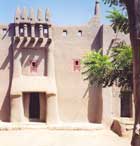
Heavenly Mud: Architecture and Magic In Mali 2003
Distributed by Filmakers Library, 124 East 40th Street, New York, NY 10016; 202-808-4980
Produced by Tyo Vuyk
Directed by Ton van der Lee
VHS, color, 52 min.
Adult
Architecture, Art, African Studies
Date Entered: 02/01/2006
Reviewed by Lisa Flanzraich, Queens College, Flushing, New YorkContrary to popular belief, Frank Lloyd Wright was not the originator of “organic architecture.” As the filmmakers of Heavenly Mud: Architecture and Magic in Mali point out, the indigenous people of Mali in West Africa deserve the credit for erecting buildings which echo natural forms. Moreover, we learn that the 1,000 year history of mosques, palaces, and homes built from mud are part of a tradition that honors spirit and ancestry.
We take a poetic river journey down the Niger River in Mali and visit the ancient cities of Timbuktu and Djenne. We behold timeless architecture composed of spirit, community, human scale, quietude and caring: all elements which Western architecture sorely lacks.
As the Dutch architect, Max van Huut states, “African architecture is close to nature - it is connected to it out of love - whereas modern, Western architecture breeds alienation because it is based on a market economy. It does not spring from the earth. Adobe architecture integrates male/female and body/mind dichotomies by reaching from the earth to the sky.”
A master mason, Boubakar, explains that his craft has been passed down through the generations. While Boubakar carefully spreads mud into brick molds, he also tells us that spells are an important part of keeping a house safe and secure. South of Timbuktu, another builder buries grains at the four corners of a foundation and asks for Ibrahim’s blessings. A written spell, which is placed in a cow’s horn and then nailed to a doorway, parallels the Jewish mezuzah.
We are astounded at the beauty of the mosques and houses, as van Huut says, because they are “timeless”; there is no aesthetic measurement for appreciating their beauty.
In addition to Wright, Antonio Gaudi, Rudolph Steiner, Max van Huut Ton Alberts, and Frank Gehry have also emulated adobe architecture in their work.
The filmmakers have done a fine job in both showing us the beauty of ancient Islamic organic architecture as well as the Sudanese peoples. Traditional music floats throughout this documentary and carries us back 1,000 years into history where we can imagine the daily lives of the people who have walked in the marketplaces, lived in adobe houses, and worshipped in holy mosques.